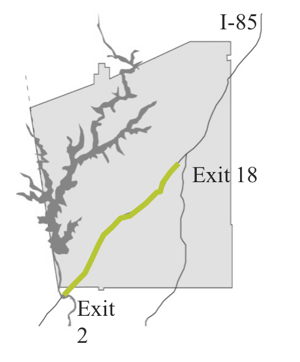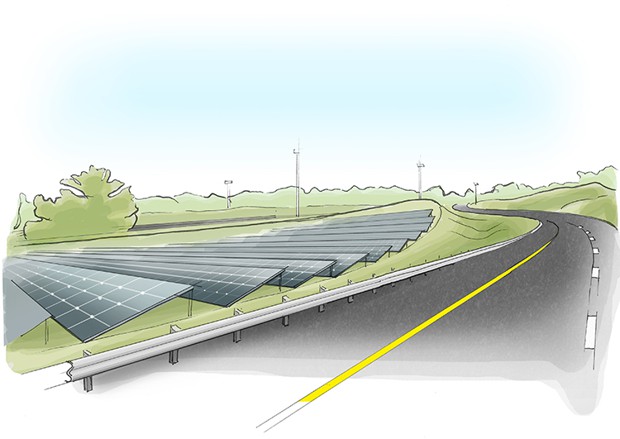Unlocking the Hidden Power of a Highway
![In this photo taken, ... ]](https://cdn.nextgov.com/media/img/cd/2017/03/16/031617highwayNG/860x394.jpg?1627515432)
In this photo taken, ... ] Rich Pedroncelli/AP
An ambitious effort in Georgia aims to turn a rural road into living lab for cutting-edge technologies.
This post is part of a CityLab series on power—the political kind, the stuff inside batteries and gas tanks, and the transformative might of mass movements.
Highways can connect, divide, and they can conquer. In that sense, they’re one of the most powerful pieces of infrastructure in the U.S. Yet when Mary Anne Lanier and Harriet Langford examined the 16-mile stretch of highway named after their late father—Ray Anderson, an entrepreneur and pioneer of industrial sustainability—they saw right through to its vulnerabilities.
“We just put the greatest industrialist of the century's name on a dirty highway,” Langford, a trustee on the board of the Ray C. Anderson Foundation, said at a Washington, D.C., conference in January. “It didn’t feel right.” Aside from getting motorists from Georgia to the edge of Alabama, the stretch of Interstate 85 does little else except threaten the surrounding environment—as highways often do.
But what if?
What if highways could turn the sunlight they’ve soaked up into renewable energy? What if they could talk to our cars and warn drivers about hazardous conditions up ahead? And what if, instead of harming the environment, they could help protect it?
Those questions are transforming an otherwise unassuming corridor into one of America’s most high-tech and sustainable roads. It flaunts an electric-vehicle charging station, solar panel pavement, and drive-over tire pressure sensors—and that’s just the beginning.
The team behind the project envisions The Ray, as the organizers call this stretch of road, to be a living laboratory for highways of the future. Working with innovation consultants and the Georgia Department of Transportation, they’re testing a mix of high- and low-tech solutions that could potentially make highways smarter, greener, and safer. The team hopes to make The Ray the first road—but not the last—to be “zero-carbon, zero-deaths, zero-waste, zero-impact.” The organizers call it Mission Zero.
At the moment, the cars that use The Ray emit 250 tons of exhaust daily and burn about 9.4 million gallons of fuel each year, according to a study by researchers at Georgia Tech. Just like any other highway, it also pollutes the waterways and disrupts nearby wildlife. This stretch of I-85 produces, for example, 70 decibels of noise pollution, enough to drive animals out of their habitat and to raise the risk of heart disease among humans.

And while electric vehicles and solar technology are gaining momentum, The Ray is just starting to embrace both. “We’re at a tipping point where sensors, cameras, and other technology have infiltrated everything else in our lives, and humans are multitasked, but not our roads,” says Allie Kelly, executive director of The Ray. “My microwave does more than the road.”
Highway to sustainability
At the Georgia welcome center, just a few miles from the Alabama state line, sits the state’s first and only solar-powered electric vehicle charging station. Kelly hopes that will attract enough EV-owners to Georgia in the long run to not only lower emissions on the road but also help boost the state economy. On the lower-tech side, they’ve also worked with GDOT to plant a 7,000-square-foot pollinator garden with species native to the state, a first step to reviving the plant life along I-85.
Then in December, the foundation brought in new technology from overseas. Hidden under steel plates installed in the parking lot of the visitor center is an array of sensors that can instantly measure the tire pressure of a car driving over it. Developed by the U.K.-based company WheelRight, it’s a first in the U.S. and, if deployed on a larger scale, it could help lower overall fuel consumption by ensuring that cars and trucks have properly inflated tires.
Perhaps the most highly anticipated feature is the 50-square-meter (540-square-foot) plot of Wattway solar roads developed by the French transportation company Colas. It first debuted in France on a half-mile road, and while it isn’t the first solar road in the U.S.—an Idaho couple has spent years testing their own version—Kelly says Wattway saves both costs and labor, because installing them doesn’t involve digging up existing roads. Instead, the seven-millimeter-thick photovoltaic cells are glued right onto the road’s surface. The power generated so far feeds into helping power the visitor center, but Kelly hopes that eventually they can expand the project onto the actual highway and feed a substantial amount of electricity into the state grid.

All that is just the tip of the iceberg, Kelly says, adding that the road will test both existing and new technologies. By the end of this year, they hope to install a solar farm along the right of way. Down the line, organizers are looking at EV charging lanes, installing bioswales to divert stormwater from the road surface, sensors to monitor safety, solar barriers to block noise pollution, and finding ways to harness electricity through hydraulics. She adds they’re already working with Georgia Tech on a drone mission to collect data on The Ray, and they are working on a patent for a new safety technology, though she held back on details.
“The vision is to have transportation assets be more valuable, more profitable, and to have better leverage in the future,” Kelly says. “It makes a lot more sense, for example, to generate more renewable energy along interstates and highways, which connect the communities that are using it, than to put it on a farm in the middle of nowhere.”
Finding room for risk
In science experiments, trial and error are key. That applies to The Ray—essentially a 16-mile-long test lab—as organizers brace themselves for projects that may prove fruitless after all. Many of the technologies being tested are in their infancy: electric vehicles are gaining ground, but are still not widespread yet. Solar roads are often the subject of criticism, for both their price and durability. When Wattway first debuted in France, on a half-mile road in Normandy, the bill came out to 5 million euros ($5.3 million)—though Kelly expects the price to go down as the technology gets better. Even so, it’s yet to be known whether the solar cells can really withstand the pressure of thousands of vehicles driving over them each day.
It’ll be years before solar roads actually move from the parking lot to Georgia’s highways, says GDOT’s director of operations John Hibbard, who emphasizes that they are still at the very early stages of testing, with still so many questions unanswered. Even if all the projects prove successful on The Ray, having one sustainable road barely makes a dent in Georgia’s vision of becoming a greener state, much less in the big picture of a cleaner America. With the cost comes a fair dose of skepticism that the solutions can be scaled up amid the reality of America’s crumbling highways and the uncertainty of what infrastructure spending will look like in the years ahead.
So far, the projects like the $40,000 EV charging station, have been funded by partnerships with companies like Kia Motors, which owns a manufacturing plant along I-85. Hibbard says that the agency is still in the testing phase and will continue to evaluate the costs and benefits when deciding which projects to invest in around the state.
At the same time, however, the low tolerance for taking chances has long been an inhibitor of advancing the country’s infrastructure and transport networks. “DOTs are generally are pretty low-risk organizations,” says Hibbard. “But working with The Ray, in some cases, can give us some opportunity to expose the two organizations together to a little bit more risk.”
Kelly sees this is an opportunity to not only embrace new technology, but also to transform funding for highways as self-driving and electric vehicles become more widely adopted. Already, fuel efficiency upgrades in cars and an increased dependency on mass transit have taken their toll on funds from the gas tax, and whatever congressional funding states can get their hands on no longer covers the costs for infrastructure projects. Kelly stresses the need to not just repurpose funding from other areas, but to create brand new revenue—something that she believes The Ray can help with. As an example, she points to the solar panels they’ll soon install.
“It's very easy to imagine that in a year not so far from today, that a DOT could work through a power purchase agreement with an installation company that also does operations and maintenance to have solar panels installed on the rights of way,” she tells CityLab. “That company will operate and manage and own those assets while the DOT gets a portion of the revenue from the sale of the electrons.” She adds that since the 40 feet of clearance on both sides of the road and the median is almost never in use, the land is prime for building an environmentally-friendly solar farm. And if Wattway proves scalable, that’s yet another source of revenue.
The Ray is as much about innovation as it is about rethinking infrastructure investment, she adds.”Would you take an investment dollar and spend it on a right of way that just sat there and waited for a driver in distress, or would you look at those infrastructure dollars and consider spending some to convert the right of way into wind and solar deployment that could start paying you back within the decade?”





